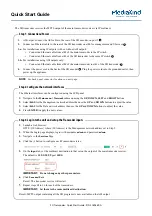
12
Alignment
UHF Transmitter Output
r
Connect the wattmeter and dummy load to the
antenna jack.
r
Enter the Alignment mode, then press the
LOW
and/or
REV
keys on the panel to select “
POM AX
.”
r
Press the
BAND
key to select “
U4 xxx
,” if neces-
sary (
xxx
= parameter).
r
Key the transmitter, and confirm that the output
power is more than 38 Watts.
r
Press the
LOW
and/or
REV
keys on the panel to
select “
PO HI
.” Press the
BAND
key to select “
U3
xxx
,” if necessary (
xxx
= parameter).
r
Key the transmitter, and rotate the
Dial
knob so
as to achieve 35 watts (±0.5 W) on the wattmeter.
r
Press the
LOW
key to select “
U4 xxx
,” if neces-
sary (
xxx
= parameter).
r
Key the transmitter, and rotate the
Dial
knob so
as to achieve 35 watts (±0.5 W) on the wattmeter.
r
Press the
LOW
key to select “
U5 xxx
,” if neces-
sary (
xxx
= parameter).
r
Key the transmitter, and rotate the
Dial
knob so
as to achieve 35 watts (±0.5 W) on the wattmeter.
r
Press the
LOW
and/or
REV
keys on the panel to
select “
PO M 1
.” Press the
BAND
key to select “
U3
xxx
,” if necessary (
xxx
= parameter).
r
Key the transmitter, and rotate the
Dial
knob so
as to achieve 20 watts (±0.5 W) on the wattmeter.
r
Press the
LOW
key to select “
U4 xxx
,” if neces-
sary (
xxx
= parameter).
r
Key the transmitter, and rotate the
Dial
knob so
as to achieve 20 watts (±0.5 W) on the wattmeter.
r
Press the
LOW
key to select “
U5 xxx
,” if neces-
sary (
xxx
= parameter).
r
Key the transmitter, and rotate the
Dial
knob so
as to achieve 20 watts (±0.5 W) on the wattmeter.
r
Press the
LOW
and/or
REV
keys on the panel to
select “
PO M 2
.” Press the
BAND
key to select “
U3
xxx
,” if necessary (
xxx
= parameter).
r
Key the transmitter, and rotate the
Dial
knob so
as to achieve 10 watts (±0.5 W) on the wattmeter.
r
Press the
LOW
key to select “
U4 xxx
,” if neces-
sary (
xxx
= parameter).
r
Key the transmitter, and rotate the
Dial
knob so
as to achieve 10 watts (±0.5 W) on the wattmeter.
r
Press the
LOW
key to select “
U5 xxx
,” if neces-
sary (
xxx
= parameter).
r
Key the transmitter, and rotate the
Dial
knob so
as to achieve 10 watts (±0.5 W) on the wattmeter.
r
Press the
LOW
and/or
REV
keys on the panel to
select “
PO LO
.” Press the
BAND
key to select “
U3
xxx
,” if necessary (
xxx
= parameter).
Internal System Alignment Routine
This uses a programmed routine in the transceiver
which simplifies many complex discrete component set-
tings and adjustments using digitally-controlled settings
via the front panel’s buttons and LCD indications.
The examples below assume that the transceiver is to
be used in a 4-MHz-wide band (144-148 MHz). The facto-
ry-default settings for the FT-7100M assume a wider trans-
mit frequency range, so a "trick" must be used to set up
the frequencies correctly.
m
In the Alignment mode, a special memory table
(see below) is temporarily established, providing
pre-set frequencies to be used in the alignment
process.
CH
VHF
UHF
1
108.000 MHz
360.000 MHz
2
137.000 MHz
390.000 MHz
3
144.000 MHz
430.000 MHz
4
146.000 MHz
440.000 MHz
5
148.000 MHz
450.000 MHz
6
165.000 MHz
460.000 MHz
7
180.000 MHz
480.000 MHz
Note: For transceivers operating on 144-146 MHz,
use more appropriate frequencies, like
145.000/435.000 MHz (CH 4), 146.000/
440.000 MHz (CH 5).
m
To enter the Alignment mode, turn the transceiver
off.
Now, short pins 1 and 6 of the
MIC
jack to Ground
(pin 4). While these two pins are shorted to
ground, press and hold in the
HOME
key while
turning the transceiver on.
m
Disconnect the shorting of pins 1 and 6 of the
MIC
jack to Ground; the transceiver is now in the
Alignment mode.
m
In the Alignment mode, each Alignment Menu is
selected by the
LOW
(increase) and
REV
(de-
crease) keys; band change (VHF or UHF) is ac-
complished by the
BAND
key; and adjustment of
the setting is accomplished by rotating the
Dial
knob.
m
Once you have completed adjustment of each re-
quired Alignment Menu item, pressing the
TONE
key will lock in that setting.
m
If the alignment step requires that you “key the
transmitter,” this may be accomplished by short-
ing pin 6 of the
MIC
jack to Ground.
m
To save all settings and exit to normal operation,
press the
V/M
key.
Summary of Contents for FT-7100M
Page 4: ...4 Block Diagram...
Page 18: ...MAIN Unit Lot 1 Note 18...
Page 22: ...MAIN Unit Lot 5 Note 22...
Page 52: ...52 MAIN Unit Note...
Page 54: ...54 PANEL Unit Lot 1 Note...
Page 56: ...56 PANEL Unit Lot 1 Note...
Page 58: ...58 PANEL Unit Lot 5 Note...
Page 60: ...60 PANEL Unit Lot 5 Note...
Page 64: ...62 PANEL Unit Note...
Page 65: ...65 Parts Layout Side A Side B Circuit Diagram VR Unit Lot 1...
Page 66: ...66 Parts Layout Side A Side B Circuit Diagram VR Unit Lot 5...













































